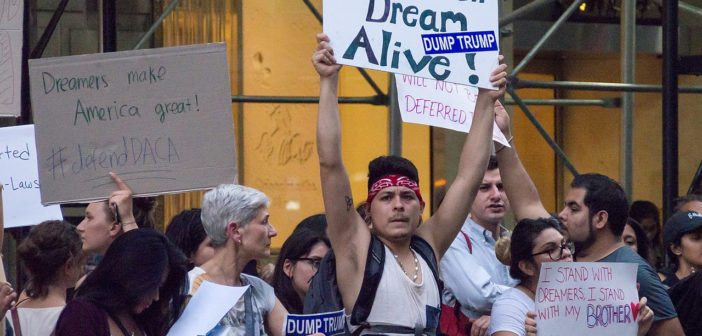After a turbulent nine months in office, President Trump has made some drastic and ambitious decisions in his presidency. From issuing the controversial banning of Muslim immigrants from a set list of Muslim majority countries to the dissolution of DACA, Trump has made headway and encountered some roadblocks in achieving his campaign promises. Unfortunately for the public, and even Congress, for that matter, it is difficult to say what Trump currently wants to do or in what direction he wishes for America to be headed domestically.
Aside from the American Health Care bill and his staunch stance against immigration, little is known about what Trump’s plans are for the future. Seemingly, according to various political analysts such as those found at FiveThirtyEight, Politico, and the New York Times, Trump is determined to dismantle Obama’s legacy but has so far been unsuccessful. Mr. Frank Orlando, an instructor of political science, expressed concern over the lack of information that Trump is willing to share if he has any information to give at all regarding his plans.
“He would like that (to destroy Obama’s legacy) since DACA is something that he did. It’s very vague to know what he wants, however. Does anyone know?” said Dr. Orlando.
Orlando commented that Congress is confused as to what Trump would like to accomplish, leading to many Republicans voting against the party, especially in regards to the two attempts at passing the American Health Care Act, and the most recent attempt looking grim for the Republicans in favor as the votes simply aren’t there for passage in the Senate, that bill being the newly proposed Graham-Cassidy bill which aims to repeal Obamacare, similar in wording to the prior two attempts. Without partisan support going forward, Republicans may find themselves unable to accomplish much.
What this means for the nation is probably more violence and protest. As seen in Charlottesville just a month prior, white nationalist and anti-fascist groups continue to clash across the country violently as each side had their own opinion on which direction the nation should take.
“Alt-right groups probably feel emboldened (by Trump)” said Dr. Orlando. “But Antifa and the Alt-right help each other.”
In essence, Orlando claimed that as white nationalism rises, so does the anti-fascist groups, such as Antifa and Black Lives Matter. It isn’t a stretch to say without strong leadership from the executive branch as well as a definitive guiding policy from the top, protests will continue to persist and grow, and potentially escalate as time goes on.
What can be explored is changes Trump has expressed in his campaign, but do not have a definitive plan as of yet. For instance, the idea of bringing back coal mining and manufacturing as well as the larger industrial sector of the American job market. Bringing about more competition among businesses to lower prices on consumer goods. The plan to place a tariff on foreign goods, especially goods from China, to encourage spending on American goods and spur American manufacturing. All of these ideas appeal to Trump and his voter base, but currently, have not been acted upon at this time and do not have a plan to the knowledge of the public.
Another huge plan Trump aimed to accomplish was the construction of a wall, along the US-Mexican border to deter and keep out immigrants coming from Latin America. According to the Washington Post, the wall’s construction could cost upwards of $25 billion, most of which would have to be paid using taxpayer’s money as Mexico has objected continuously to the idea of themselves footing the bill. So far, no blueprints for said wall have been made, and no one has come forward regarding the dimensions of this wall, aside from Trump himself claiming it would be “impenetrable, physical, tall, powerful, and beautiful.”
Recently, Trump did, however, unveil his tax plan. This is a move coming after months of a president seeking to make a fundamental change to America’s domestic landscape. Trump has proposed a slash in the corporate tax rate from 35 to 20 percent as an incentive for companies to stay in America versus sending their jobs overseas. Additionally, the president has proposed a new progressive tax plan, the rates being 12 (down from 15), 25 (down from 28), and 35 (down from 39.6) percent respectively from lowest income to highest, with a proposed additional surcharge added onto the wealthiest of Americans. Trump also proposes an effort to simplify the tax code so Americans can file their taxes on a single page.
This is a comprehensive tax cut, one that will plunge America, according to top government economists, $4.2 trillion more into debt. The new plan has members of Congress in support on both sides of the aisle, with more Republicans than Democrats criticizing the plan for its massive debt increase. However, it is projected that this plan will put much more money into the pockets of consumers, lowering the prices of consumer goods as well as giving Americans more money to spend overall.
Time will tell what other plans Trump aims to make. However, those plans may need to be put on hold as Robert Mueller’s investigation continues, the object of which is to figure out if there was any connection between the Trump campaign and Russia, specifically if Russia helped elect Donald Trump into office. Trump also has to worry about his constantly shifting staff as more and more cabinet members resign, meaning Trump and his close circle would have to find replacements for key positions in the executive branch, further postponing any plans Trump’s formulating with his advisors.





